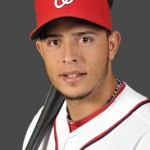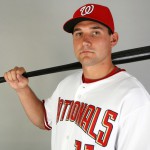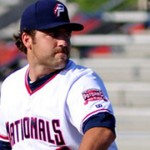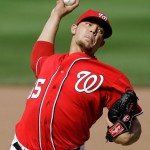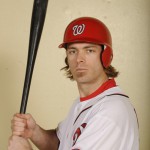
Werth; the most expensive lead-off hitter in the majors? Photo Mitchell Layton/Getty Images NA
Another edition of mlb.com Nats beat reporter Bill Ladson‘s inbox for 11/16/12. As always, I write my responses before reading his and edit some questions for clarity.
Q: Why are the Nats looking for a lead-off batter when Jayson Werth appeared to do the job very well in 2012? Do the Nats think someone can do that job better, or do they think Werth belongs elsewhere in the batting order?
A: A decent question, which the questioner answered him (her?) self, frankly. From quotes I read from Davey Johnson at the time, when Jayson Werth came back from the wrist injury the team was missing any reasonable lead-off option and Johnson asked Werth if he’d do it. He enthusiastically said yes. My personal opinion is that Werth’s wrist injury probably wasn’t entirely healed to his liking, thus sapping his power stroke and making it easier for him to focus on contact hitting and OBP from the lead-off spot than it would be for him to return to his middle-of-the-order power. He couldn’t have had a better lead-off hitter-esque split from his time there; .309/.388/.450 when hitting from the #1 position this season. That is fantastic. But realistically the Nats need to find another, proper lead-off hitter for two main reasons (one practical, one political); Practically; Werth is a bigger, better hitter than a lead-off guy and needs to be in the middle of the order, driving in runs with his power potential. Politically; you don’t spend #126M on a lead-off guy. I hate to say it, but it is what it is. I wish the Nats had a better internal lead-off option; Danny Espinosa is the natural person to install there. Switch hitter, a very good hitter in the minors. But so far in his career he’s incredibly strike-out prone, his average is disappointing and his lefty/righty splits are awful (as addressed in a separate question further down). The reason the “Nats want a lead-off-centerfielder” rumors won’t go away is directly tied to this fact. Ladson agrees, mentioning frequent FA target Michael Bourn and Angel Pagan as options.
Q: Given Roger Bernadina’s improved hitting this past season, is there any possibility that the Nats may try him as a leadoff hitter?
A: Roger Bernadina absolutely turned a corner professionally in 2012, increasing his OPS+ figure fully 30 points from 2011 and posting a split line of .291/.372/.405. Yeah, that’d be a fantastic line to have at lead-off. I’ll freely admit that I thought Bernadina was closer to a DFA than he was to a valuable spot on this team last spring training. We already know just how good a center-fielder he is defensively, and he’s lefty so he puts another lefty bat in the lineup and would allow the team to move Bryce Harper deeper into the order. Imagine a lineup of Bernadina-Desmond-Zimmerman-Harper-Morse-Werth-Espinosa-Suzuki; LRRLRRSR, giving good lefty-righty balance through the lineup. This lineup of course assumes Adam LaRoche departs as a FA (which I think is likely). Now, do I think this is going to happen? No. I believe the team views Bernadina as a 4th outfielder, a super-sub, defensive replacement for later innings and he thrived in that role last year. But that being said, if the FA market proves too costly (or if the Nats choose to go all-in on a SP and leave the batting lineup as-is), this is absolutely a viable option to try in 2013. Ladson agrees with my sentiments; the Nats view Bernadina as a 4th outfielder.
Q: What do you think of Tony Beasley taking over as Nats manager after Davey Johnson calls it quits? Beasley has the experience. He just needs a chance.
A: Honestly I’d expect Mike Rizzo to bring on-board a more experienced skipper if/when Johnson hangs them up. Perhaps someone from his Arizona days. How many teams really promote from within for on-field management? Ladson thinks Randy Knorr is the heir-apparent.
Q: Why don’t the Nats consider left-hander John Lannan a No. 4 or 5 starter in ’13? Lannan showed he can pitch well in the past.
A: Man, how many times have I answered this question? Lannan is a league-average pitcher, posting a career ERA+ of 103. He isn’t a fireballer and rarely “dominates” a game. Mike Rizzo wants power arms and just doesn’t rate Lannan. He’ll look here and high for a harder-thrower for the 5th starter spot and is likely to roll the dice with hurlers Ryan Perry or Christian Garcia before he goes with Lannan next year. Besides; Lannan would need to be tendered a contract and likely earns at least a nominal raise over the $5M he earned for toiling in AAA last year. It just is not good value to pay $5M for a 5th starter when you’ve got MLB-minimum guys that can possibly do the job just as well. Look for Lannan to get non-tendered and be pitching for a 2nd division team in 2013. Ladson mirrors exactly what I wrote here.
Q: What are the chances of our GM, Mike Rizzo, going after a shutdown closer?
A: Zero. Rizzo (rightly so in my mind) doesn’t rate closers on the open market as worthwhile investments. I agree; I think relievers are fungible assets that are to be used and discarded as needed. Now, if a former closer can be had on the open market cheap, Rizzo absolutely will bring them in. He’s done this more than once in the past; Brad Lidge in 2012, Matt Capps in 2010. Lidge didn’t work out at all but he only cost the team $1M. Capps turned out fantastically, made the all-star team and was flipped for Wilson Ramos in what I think is Rizzo’s best trade (well, the Gio Gonzalez trade wasn’t half bad either). The pickings on the closer FA market are slim, but I could see the team taking a flier on an injury reclamation project like Ryan Madson or Brett Myers. Perhaps even re-signing Capps, who lost his closer role and could be inserted in middle-relief. We do have bigger priorities though; namely replacing our 3 lefty specialists (Tom Gorzelanny is still tied to the club but isn’t a guarantee to get tendered). Ladson says the team has a shutdown closer in Drew Storen and will focus elsewhere.
Q: Is Danny Espinosa really a switch-hitter? He is just horrible from the left side. Why doesn’t he just bat from the right side?
A: Great question, one that I’ve asked many times myself. His career splits lefty/righty are pretty telling. .227/.306/.393 from the left side, .276/.346/.467 from the right. He’s an all-star caliber hitter from the right-side only, posting a 124 OPS+. I privately wonder if the team isn’t going to make the decision for him, and a full spring training just hitting from the right-side could be in order. Of course, his value as a right-handed only hitter is greatly diminished. Plus there’s a life-time of adjustments to be had; if you’ve been facing right handed arms from the left side your whole life, who is to say that you won’t similarly struggle once you’re seeing breaking pitches from the other side? A tough call. My gut says he sticks it out and the team shows the same patience with him that they showed with Desmond, who rewarded the team with a breakthrough 2012. Ladson reports that Johnson has “all the confidence in the world” in Espinosa. Looks like 2013 is a make-it or break-it year for him.
Q: Can Zach Duke start for the Nationals? How does he compare with Zack Greinke?
A: Wow; comparing Zach Duke (a minor league FA signing this year with a career 49-74 record) to Zack Greinke (inarguably the top FA pitcher on the market with a Cy Young to his name) is sort of like comparing a fast-food joint to a steak-house. There is no comparison; Duke is going to be lucky to get a guaranteed contract while Greinke is likely to get a nine-figure deal. Can Duke start for this team? Well, assuming the team resigns him (he’s a free agent) he’s not even as good as Lannan, who they could lock up for 2013 if they choose. And (as discussed above) if the team doesn’t rate Lannan they certainly wouldn’t rate Duke. I don’t think Duke even could feature as a LOOGY; he likely seeks another shot at starting in 2013 somewhere. Ladson agrees, albeit without the hyperbole of my answer.
Q: What will the Nats do with Yunesky Maya? He appears he found himself while pitching a full season with Triple-A Syracuse.
A: I’d hardly say 11-10 with a 3.88 ERA in AAA is “finding himself.” I’ll admit Yunesky Maya had some decent starts down the stretch, but he also had some awful ones. Just like he did all season. Maya got two shots in 2010 and 2011 to stick in the majors and failed both times. I don’t think he’ll get a third. Look for the Nats to obtain a 4th minor league option on Maya by virtue of his having fewer than 5 pro seasons and him spending 2013, his last of a 4yr $8M contract, as starter insurance in Syracuse again. Ladson states that Maya is rule-5 eligible; Uh, perhaps you need to read up on the purpose of that draft Bill. Its for NON 40-man roster guys.
Q: What’s up with Chris Marrero? Haven’t heard anything about him replacing Adam LaRoche at first base.
A: Another lost season for Chris Marrero, who spent a huge amount of time recovering from an off-season hamstring injury and ended up playing just 37 games in Syracuse after several rehab stops in the lower minors. Zero home runs in AAA for the year. I hate to say it, but Marrero has been passed by on the depth chart for first base, and the team would absolutely look at Michael Morse first and Tyler Moore second to man first base at the major league level before giving Marrero a shot. His positional inflexibility really hurts him, in that he’s not showing the kind of power you need to at the position to get promoted upwards. He’s still young though (born in 1988, he’s only 24). Maybe he’s worth including in trade to another club. Ladson didn’t say much; i’m not sure he really knows what the team plans for Marrero either.
